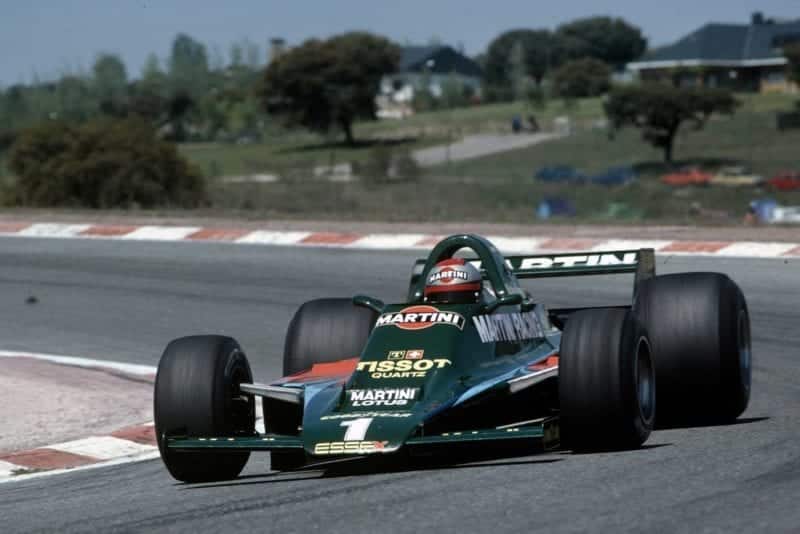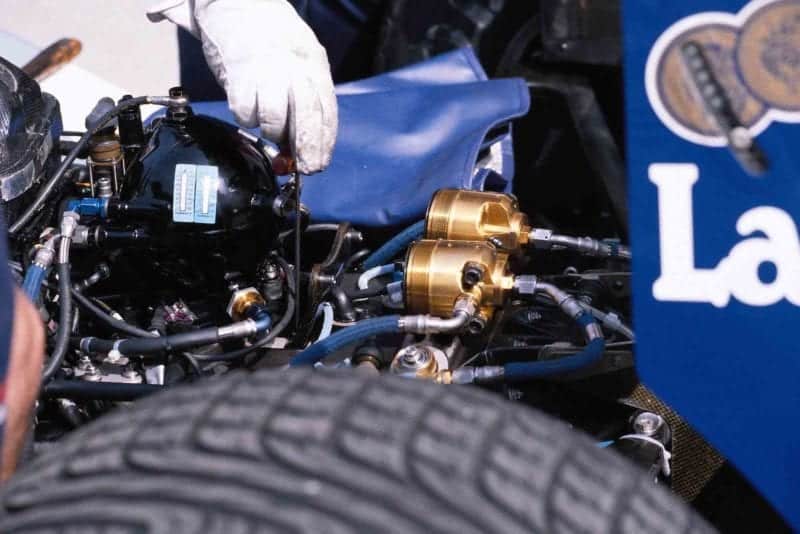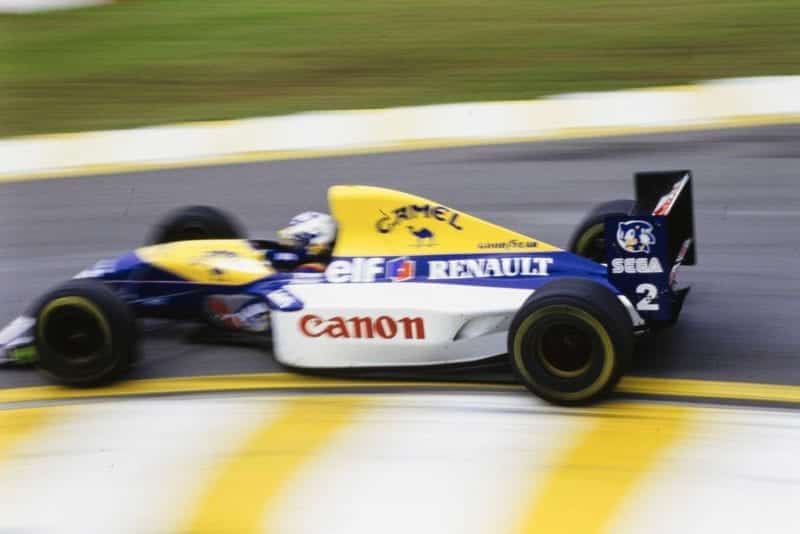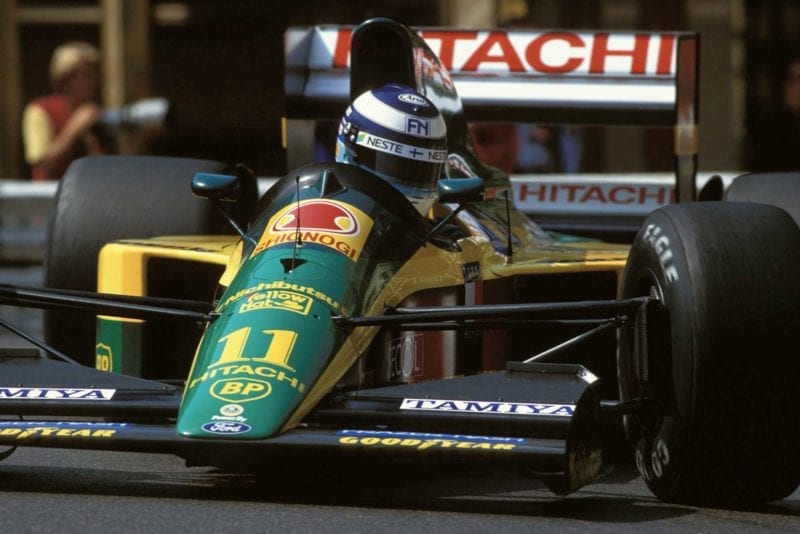Active suspension
Formula One cars' active suspension of the late 1980s-early 1990s took motorsport technology to new levels. Keith Howard explains how springs and dampers almost became things of the past— and then bounced back.

Ayrton Senna rounds the hairpin at the 1987 Monaco Grand Prix
Motorsport Images
Search the worldwide web using ‘active suspension’ as keywords and you will quickly find claims that Williams invented the technology in 1992, and that it works by predicting the contour of the road ahead. Not sensing the road contour, note, but predicting it. With tarot cards?
The truth about active suspension is stranger, or at least more engaging, than the abundant fictions. Actually, the first F1 car to use active suspension was the Lotus Type 92, and it took to the track as early as 1983 — four years before active suspension scored its first win and nine years before securing its maiden championship.
Although ‘active’ is used as a catch-all description, the pioneering Lotus and Williams systems were quite different in their realisation, their design philosophy and their origins. Whereas the Lotus system was inspired by aeronautics technology, Williams’ was derived from a road vehicle system originally developed by Automotive Products. In fact, the essentials of the suspension which first appeared on the Williams-Honda FW11B in 1987 and returned, in improved form, to sweep all before it in 1992-3 on the FW14B and 15C, was shown off by AP on, of all things, a Ford Granada.
Father of the Lotus active system was Peter Wright, then Team Lotus aerodynamicist (and now technical adviser to the HA and a motorsport writer). In 1980, Lotus was grappling with the problem of controlling the burgeoning levels of downforce being generated by the latest generation of ground effect F1 cars — four times the downforce the Lotus 79 had developed only two years earlier.
With the Lotus 80, which developed its downforce almost entirely via ground effect, eschewing conventional front and rear wings, Wright and his colleagues had generated huge downforce but, by his own admission, they had lost control of it. In particular, Lotus had run into the problem of ‘porpoising’, where changes in pitch angle over a bump could lead to a severe pitch resonance, the car rapidly cycling between nose-up/tail-down and nose-down/tail-up attitudes as the downforce and its position of action varied in synchrony with the pitch changes. This violent behaviour, which was heart-stopping for the driver, could only be stifled by applying the brakes. Lotus tried to cure it by stiffening the suspension, but it didn’t help: the car bounced around on its tyres instead.
Professor David Williams of the Cranfield Institute of Technology was commissioned to analyse the problem, which he identified as something akin to wing flutter in aircraft. During one of their meetings in 1980, he suggested a possible solution to Wright— the synthetic springs his department was developing as part of an artificial-feel control column for a fly-by-wire research aircraft. Comprising a hydraulic ram with fast-acting computer-actuated control valves, a synthetic spring could replace the conventional spring and damper, relieving suspension design of many of its traditional compromises. Most importantly, it could provide the rapid-acting, adaptive control of ride height necessary to banish porpoising and maintain the car at the optimum ride height and angle of attack. The need for ludicrously hard springs would then be removed, which as well as making life more comfortable for the buffeted driver, would reduce the variations in tyre load caused by uneven track surfaces and so maximise grip.

The alarming ‘porpoising’ effect of the Lotus 80 prompted the development of active suspension
Motorsport Images
Promising as it sounded, active suspension initially became Plan B at Lotus. Plan A was the twin-chassis Type 88, which addressed the downforce problem by the simpler, purely mechanical means of incorporating two suspension systems. When the revolutionary 88 was outlawed under pressure from opponents who feared Chapman was again moving the goalposts, active suspension replaced it as the focus of Team Lotus’ development effort.
Chapman wanted to run active in 1983, so he presented Wright with an incredibly tight timetable for such a major development: just six months to develop active suspension on an Esprit demonstrator, then six months more to develop an active F1 car — assuming the Esprit had proved the concept. Sharing the development work with Williams at Cranfield, who wrote the control software and built the computer hardware to run it, Wright set about the task.
On schedule, the Esprit was completed and went to Snetterton, down the road from Ketteringham Hall, for testing. With Elio de Angelis driving, Wright was quickly able to optimise the car’s setup from the passenger seat so that when the boss arrived de Angelis was able to take him for a ride and show off the car’s full capabilities. Convinced by the demonstration, Chapman gave the F1 car the go-ahead.
“Mansell has said some things since which absolutely amaze me, but it wasn’t half the things he said”
After another six months of intense development effort, the active Type 92 ran for the first time on December 16, 1982, again at Snetterton, with test driver Dave Scott behind the wheel. It was a significant event for Lotus, but not nearly so momentous as what occurred in the early hours of that same morning when Colin Chapman died from a heart attack. With his passing, the impetus to develop active suspension into a race-winning technology was lost.
Although Lotus ran the active, Cosworth-engined 92 at Rio and Long Beach in 1983, the team’s principal focus was on running the sole 93T, with its Renault turbo engine, for de Angelis. Wright felt justifiably proud that the active car had completed its first two grands prix, finishing 12th both times, but others were less impressed.
Nigel Mansell, its driver, was one of them. He complained that active added weight and stole engine power, and he never really trusted it. There’d been some scary moments during the system’s development, although things were never as bad, Wright says, as Mansell was later to relate: “Mansell has said some things since which absolutely amaze me. It was fairly traumatic, but it wasn’t half the things he said.”

Close up detail of the 1992 Williams FW14B’s rear active suspension
Motorsport Images
Active was removed from the 92 and Mansell continued to campaign it, with conventional passive suspension, until he and de Angelis got their hands on the new 94T. Even with 20kg removed and a few extra horsepower on tap, the 92 continued to perform poorly, disproving the contention that active had nobbled it. But this wasn’t a message to which Team Lotus management was by then receptive. For Peter Warr, active suspension was already off the agenda. With a brief to develop the technology for road cars instead, Wright was packed off to Lotus Engineering at Hethel.
By the time Team Lotus reinstated active for the 1987 season on the Type 99T, at the behest of designer Gerard Ducarouge, it had already lost its advantage. The same year Williams ran its first active system on the FW11B — and had a much better season with it
Designed by Frank Dernie, the Williams system was technically less adventurous but, Demie argues, more closely focused on the task of optimising the car’s aerodynamic performance.
“I didn’t give a damn about ride quality. The driver was paid to deal with bumps,” he says. ‘All I wanted to do was make the car quicker.”
Dernie, who among other responsibilities was Williams’ aerodynamicist, had come to the same conclusion as Wright: that the only way to maximise aerodynamic performance was to have a suspension system that could maintain ride height within a few millimetres of optimum.
“You could easily make a racing car that was aerodynamically banal and insensitive to ride height,” he says, “which meant it was easy for engineers to setup, easy for drivers to drive — but not very quick. Or you could make one that was much more pointed. I never found an aerodynamic solution which gave good downforce and was easy to set up.”
So Dernie approached Automotive Products with a view to using the ‘active’ suspension system it had developed for road vehicles.
AP’s system was less complex than the Lotus one, and not able to optimise wheel kinematics to the benefit of ride quality and dynamic tyre load. But Dernie didn’t care about ride quality, as already noted, and he regarded ‘mechanical grip’ as a fallacy. At almost any cornering speed the grip available to an F1 car is dictated principally by the amount of downforce it generates, so Dernie’s sole focus was on maximising aerodynamic download.

Active suspension’s ultimate expression was the Williams FW15C of 1993. It scored 10 grands prix wins that that season and took Alain Prost to his fourth title
Motorsport Images
AP’s system provided the means to achieve this by closely controlling ride height, so nothing more elaborate was required. As Dernie himself wryly expresses it, “Optimising something that doesn’t make the car go quicker is always something I’ve tried to avoid.”
In fact, the AP system was so simple that it barely merited the term ‘active’. Although it relied on powered hydraulics, there was no computer control and no means by which force could be applied arbitrarily to any wheel. Williams would refer to the system as reactive, in response to Lotus insistence that ‘active ride’ was its terminology, and really this was a more accurate description since movement at one wheel was communicated across the car by a system of hydraulic connections. Patrick Head reverted to calling the system active when it was redeployed, in enhanced form, in 1992, but arguably the reactive label is more appropriate.
The adjacent diagram shows the system as originally conceived by AR It comprises three Citroen-like gas spring/damper units, four actuators, three control valves and the pump, tank and accumulator of the pressurised hydraulic supply. Two of the hydraulic actuators are double-acting devices, in which the piston can be forced in either direction; the other two are single-acting types in which the piston can only be forced downwards. The control valves are mechanical, operated via a rod from the suspension arm, and incorporate a mass/spring/damper arrangement that acts as a mechanical low-pass filter. This prevents it reacting to high frequency bump movements but allows it to respond to lower frequency inputs caused by the car body bouncing, pitching and rolling.
It was an exact copy of this system that Dernie fitted to his FW10 development mule, bar one important change. Whereas in the AP system the double-acting hydraulic struts were fitted to the rear of the car and the single-acting struts to the front, in the Williams system this disposition was reversed. It’s an important change, Dernie says, although he declines to explain why. Some subtleties of the system are still not widely appreciated, he believes, and he sees no good reason to offer enlightenment. After all, nobody can guarantee that active has been banned from Formula One in perpetuity.
Apart from the mechanical filters, which had to be replaced with electronically-controlled servo valves because it proved impossible to get the mass/spring/damper arrangement to work within the necessary tolerances, the adapted AP system worked well straight out of the box. Dernie had drawn up three sets of parts in case his first stab at the roll stiffness distribution was wrong, but the drivers liked the first set-up so much that the second and third variants were never made.

Lotus brought back active suspension for 1992/1993, but unfortunately performance in the rest of the car was lacking
Motorsport Images
Fitted to the FW11B for the latter part of the 1987 season, the reactive system did Williams proud. The car had already proved itself a winner in passive form when the active version won its first race with Nelson Piquet at Monza. Until that point Mansell had refused to drive it, but a second active car was hurriedly built for him to use for the next race at Estoril. While Senna’s active 99T scored only two victories, on the bumpy streets of Monaco and Detroit, the FW11B eventually won at nine races (three of them in active form), won the constructors’ championship and placed Piquet and Mansell first and second in the drivers’ title race.
Needless to say, Williams opted to keep the reactive system for 1988, but over at Lotus it was another story. Lotus Engineering had bankrolled the 99T’s active suspension all year, sending two engineers to each race, and reckoned by season’s end that it had proved the system to be reliable and a race-winner. So the following season they would want paying for it. Warr said no thanks, and for a second time Wright watched helplessly as Lotus’ active suspension expertise was squandered. By the time Team Lotus ran active again in 1992 and 1993 — using a fast-ride system on the 107, and then full active on the 107B — it was, according to Wright, “a Minardi, struggling desperately to keep going”. The technology lead that might have returned Lotus to the top of the sport had been frittered away.
“Wright watched helplessly as Lotus’ active suspension expertise was squandered”
As it happened, Williams did not repeat its 1987 success in ’88, and Dernie admits it was all his fault: “The problem with the FW12 was just the fluid reservoir. The 11B had had a tall, narrow reservoir which we could pre-pressurise using a tapping off the turbo boost regulator. So the inlet to the hydraulic pump was always covered. The oil tank in the 12 wasn’t good enough. It didn’t always pre-pressurise and it could allow air into the system. So the car was stunningly fast for about three or four laps then, once there was air in the system, it was completely undriveable. We didn’t find out that the problem was the reservoir until much later.”
Williams dropped active suspension for the 1989, ’90 and ’91 seasons, but returned with an enhanced version in ’92, creating such successful cars in the FW14B and FW15C that the FIA decided to ban the key technologies credited with their success.
Across 11 seasons, active suspension had fitfully advanced from zero to hero, only for those who’d had the foresight to develop it to be told that they were ruining the sport.
And so the FIA banned it. If you listen carefully you may hear the distant voice of Colin Chapman cynically exclaiming, “I knew they would!”
